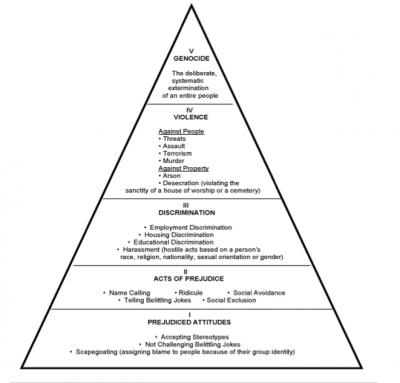IWitness in Action: Teaching the Bystander Effect
As educators, when we go into teaching, we go in with what some might call ideological visions: This concept that we can and will make a difference; this idea that the children we teach will take the lessons we’ve taught and use them to become productive people long after they leave the four walls of our classroom. As we sit here now, reflecting on our most recent efforts to teach the Holocaust in a profound manner that gives justice and honor to the victims of this atrocity, we feel fortunate that such ideologies are being lived in our classroom.
In approaching any teaching of genocide, one should be cognizant of the sensitive issues not only the students but also for the educator to address: The premise of hate in society, and how it has the ability to escalate into the horrors of genocide. How do you begin a dialogue with middle school students about prejudices stemming from race, ethnicity, and religion? And, how do you answer questions that students asks.
How can people let something like the Holocaust and other genocides occur? How can people let mass murder and torturing of others on a large scale occur? How in the world could a people, a nation, adopt ideology and execute such horrific acts? How in the world could people, a government, legalize discrimination to the point it justified mass murder?”
As educators, we don’t always have all the answers. So, how does one explain how hate, pure discrimination could escalate to violence and ultimately genocide with the rest of the world watching in the wings? Answer - who knows? It is a bit mindboggling. And, you admit this to students. Yes, you admit to students it is difficult to understand and sometimes you struggle to understand these things yourself, but you let them know you are going to do your best to not only answer these questions but show them. It was with this that we decided to explore and implement the work of the USC Shoah Foundation and IWitness into our classroom with astounding results.
 To tackle a subject as complicated as genocide we started with the Pyramid of Hate. This activity introduces students to the definitions of genocide and how it is able to occur so quickly in a world, in which democracy is seemingly at the hearts of many Western cultures. As the lesson continued, several things became abundantly clear.
To tackle a subject as complicated as genocide we started with the Pyramid of Hate. This activity introduces students to the definitions of genocide and how it is able to occur so quickly in a world, in which democracy is seemingly at the hearts of many Western cultures. As the lesson continued, several things became abundantly clear.
First, we must always be conscientious of the voices in our heads telling us it is not okay. And second, we have a moral and ethical duty to challenge any such voice who would discriminate. Recently, USC Shoah Foundation published an article on our work that led to a deeper exploration of how we can be a force of good change.
In the modern era that we live in, Twitter has become a powerful tool in the way educators collaborate and share ideas with one another. It was thanks to an IWitness Twitter chat, which we reviewed how to be culturally responsive educators. From that moment we started our most powerful lesson.
The IWitness activity The Bystander Effect, blends Common Core standards with technology to create a powerful outpouring of support and declarations to speak out against injustice. After engaging with eyewitness testimony to the Genocide Against the Tutsi in Rwanda, students created their own videos that not only addressed the essential elements of becoming an upstander, but also required that students demonstrate how they could make a change within the video, using the hashtag #beginswithme.
In our classroom, we gave a unique twist to this assignment. Our students combined the hashtag, #beginswithme with the message written in banner format in the top 10 languages of the world. In their video students highlighted the need to address this issue globally, as one voice.
As educators, it is important to educate students on what happened in the past, how it shaped legislation and movement forward, and how it connects to the present. It is the only way for students to be more cognizant about the world in which they live and proactively combat hatred and intolerance.
In order to build tolerance, to see another perspective or at least entertain another point of view, it is important for our students to be aware that racism still exists and everyone has prejudices that dictate movement forward, as an individual or collectively as a society. If we are aware, we can monitor our actions, our words, and open our minds to change the world and improve relations for a better tomorrow.
An ideal that is important to competing and navigating in a global society - one voice and one act at a time. Now you can make sure your students learn this important lesson by implementing the Bystander Effect activity in your classroom.
Because it #BeginsWithMe and it #BeginsWithYou.